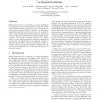Free Online Productivity Tools
i2Speak
i2Symbol
i2OCR
iTex2Img
iWeb2Print
iWeb2Shot
i2Type
iPdf2Split
iPdf2Merge
i2Bopomofo
i2Arabic
i2Style
i2Image
i2PDF
iLatex2Rtf
Sci2ools
MICRO
1994
IEEE
1994
IEEE
Characterizing the impact of predicated execution on branch prediction
Branch instructions are recognized as a major impediment to exploiting instruction level parallelism. Even with sophisticated branch prediction techniques, many frequently executed branches remain di cult to predict. An architecture supporting predicated execution may allow the compiler to remove many of these hard-to-predict branches, reducing the number of branch mispredictions and thereby improving performance. We present an in-depth analysis of the characteristics of those branches which are frequently mispredicted and examine the e ectiveness of an advanced compiler to eliminate these branches. Over the benchmarks studied, an average of 27 of the dynamic branches and 56 of the dynamic branch mispredictions are eliminated with predicated execution support.
Branch Mispredictions | Hardware | MICRO 1994 | Predicated Execution | Sophisticated Branch Prediction |
| Added | 09 Aug 2010 |
| Updated | 09 Aug 2010 |
| Type | Conference |
| Year | 1994 |
| Where | MICRO |
| Authors | Scott A. Mahlke, Richard E. Hank, Roger A. Bringmann, John C. Gyllenhaal, David M. Gallagher, Wen-mei W. Hwu |
Comments (0)

